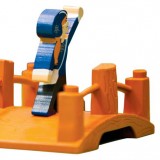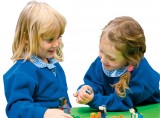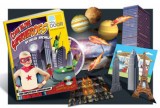Helen Bromley invites you to take superhero play into a miniature world of storytelling wonder...
Creating miniature environments that can be inhabited by superhero figures will stimulate a myriad of cross-curricular opportunities. Children enjoy small-world play as it enables them to take control over an imagined location, breathing life into its inhabitants and creating a whole array of narratives.
Create a place where children will be able to have access to the small-world and where, preferably, it can be kept out from day to day. This will encourage children to develop their ideas over a period of time and give adults ample opportunity to extend the play.
A tray to contain the small world
This can be of any shape. Remember that a large tray will offer ease of access and will promote discussion and collaborative talk.
Materials to create the base of the environment
This might include:
• glittery coloured sand
• foil – silver or coloured
• treasure nuggets
• a range of interesting fabrics
• artificial grass.
Remember that the more open-ended the resources, the more creative the children can be.
Inhabitants
You may wish to use:
• play people – the more the merrier!
• additional superhero characters that children might bring in from home
• the Come Alive Superheroes wooden character set (yellow-door.net)
• photos of individual children in your group preferably head-to-toe photos), cut out and laminated for durability, with a clothes peg to make them stand up.
Keep these sets of characters in clearly labelled separate containers (tubs, baskets, etc.) for ease of access.
Props
You could offer:
• model cars and trains
• small blocks to create buildings
• printed pictures of planets, comets and other space objects
• pictures of landscapes to use as backgrounds.
 Many young children will be experienced in creating small-worlds and will thoroughly enjoy the opportunity to create the miniature superhero environment from scratch. Involving children in creating the small-world will increase ownership of the resource whilst allowing a whole host of learning opportunities that are lost when an adult’s ideas are allowed to dominate.
Many young children will be experienced in creating small-worlds and will thoroughly enjoy the opportunity to create the miniature superhero environment from scratch. Involving children in creating the small-world will increase ownership of the resource whilst allowing a whole host of learning opportunities that are lost when an adult’s ideas are allowed to dominate.
Initially you may wish to choose one particular group of children to create the small-world. It can then be added to and adapted by other children who may wish to use it.
Perhaps when you introduce the superhero characters that are to inhabit the small-world to the children, you might begin to build an environment for them, involving the children in the decision making about the kind of place where these characters might live. This would be very exciting!
Ensure that you make the most of all the opportunities that small-world play has to offer, in terms of discovering what young children know and can do. Make time to observe and listen as the small world is created, listening out for mathematical and scientific language as well as the story openings, character descriptions and dialogue that naturally take place.
 Encourage children to tell their stories to you and each other. If the children in your group are inexperienced in this activity, give them time to practise together first.
Encourage children to tell their stories to you and each other. If the children in your group are inexperienced in this activity, give them time to practise together first.
Ensure that ample paper, mark-making materials and ready-made books are available for children who are keen to create written versions of their stories.
Whilst educators may wish to define an end to a superhero theme and draw linked activities to a close, it will remain a long-term interest for many children. Creating a superhero storybox offers a way for some children to continue playing with superheroes long after the focus within the setting has changed.
To make a storybox, obtain an empty shoe box and cut it so that one long side of the box folds down. You could also use the Magical World Storybox (yellow-door.net).
Create a suitable scene on the inside of the box, on the sides that are not folded down. You could create a scene with stars and planets perhaps, or the New York skyline. Add some superhero characters. Additional props might include decorative spheres to represent planets and small model buildings. Why not make laminated photos of the children available so that they can have an adventure in the storybox too?
Experiment with superheroes throughout the early years…
 These ideas are taken from Helen Bromley’s Come Alive Superheroes published by Yellow Door. This pack offers a wealth of ideas and resources that will help you to respond positively to children’s interests to promote high-quality learning across the curriculum. The Come Alive Superheroes wooden character set and a range of resources for small-world play are also available from Yellow Door. For more information visit ellow-door.net or call 0845 603 5309.
These ideas are taken from Helen Bromley’s Come Alive Superheroes published by Yellow Door. This pack offers a wealth of ideas and resources that will help you to respond positively to children’s interests to promote high-quality learning across the curriculum. The Come Alive Superheroes wooden character set and a range of resources for small-world play are also available from Yellow Door. For more information visit ellow-door.net or call 0845 603 5309.
1. Children may think of creating two parallel worlds for the superheroes. If possible, then do so as it will create new learning opportunities
2. Make sure you scribe some stories for the children. They will always be able to dictate a story that is of greater complexity than they can write.
Should you let educational researchers into your classroom?
Ace-Classroom-Support
